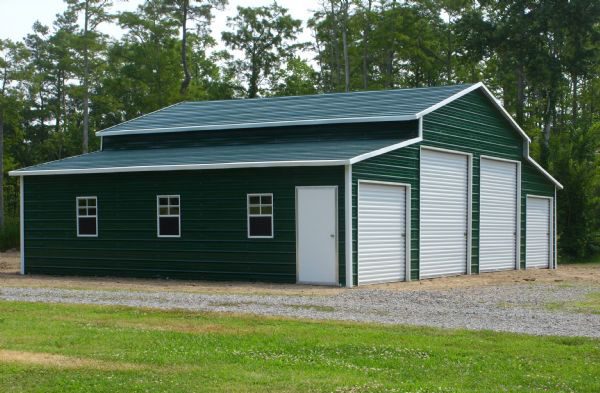The construction industry has grown tremendously, with increasing demand for durable and cost-effective building materials. One of the most popular materials used in the construction of metal buildings is the galvanized steel process. Galvanized steel offers excellent protection against corrosion, durability, longevity, and cost-effectiveness. Let’s delve into the galvanized steel process, specifically focusing on the Flo-Coat method, and explore its significance in metal buildings.
What is the Galvanized Steel Process?
Galvanizing steel involves the application of a protective zinc coating to the surface of the metal. This protective coating acts as a barrier, protecting the steel from corrosion caused by exposure to moisture, chemicals, and other environmental factors. There are several methods of galvanizing steel, but the Flo-Coat process is a specialized galvanized surface method that provides enhanced corrosion protection for steel structures.
What is the Flo-Coat Process, and How Does It Enhance Corrosion Protection?
The Flo-Coat process involves immersing the steel in a bath of molten zinc, which bonds with the steel substrate, creating a protective layer. The process is continuous hot-dip galvanizing, meaning the steel is continuously dipped into the zinc until the desired coating thickness is achieved. To understand the process works, let’s take a closer look at the step-by-step process involved:
- Cleaning and smoothing the surface: The first step in the Flo-Coat process is surface preparation. The steel is cleaned to remove any dirt, oil, or mill scale that may be present. This step is essential to ensure that the zinc coating adheres properly to the steel.
- Hot-dip galvanizing: Once the surface is prepped, the steel is dipped into a bath of molten zinc at a temperature of around 840°F (449°C). The zinc reacts with the iron in the steel to form a series of zinc-iron alloy layers. The excess zinc is removed from the surface by running it through a series of air knives. After applying the zinc coating, the steel is cooled in a quench tank to solidify the coating.
- Post-treatment: The final step in the Flo-Coat process is post-treatment, which involves either chromate or phosphate treatment to further protect the steel from corrosion.
What Are The Benefits Of Flo-Coat For Metal Buildings?
Metal buildings with Flo-Coat coating offer several benefits, including:
- Corrosion resistance: One of the primary advantages of the Flo-Coat process is its excellent corrosion resistance. The zinc coating acts as a barrier, protecting the steel from corrosion caused by exposure to moisture, chemicals, and other environmental factors. This protection is particularly important for metal buildings exposed to harsh weather conditions.
- Durability: Metal buildings with Flo-Coat coating exhibit exceptional durability. They can withstand extreme weather conditions, including heavy rain, snow, and high winds, without compromising their structural integrity. This durability ensures that your metal building will stand the test of time.
- Longevity: The corrosion protection provided by the Flo-Coat process significantly extends the service life of metal buildings. By preventing rust and corrosion, the zinc coating helps maintain the structural strength and appearance of the building for many years to come, which translates to long-term cost savings and minimal maintenance requirements.
- Cost-effectiveness: Investing in this galvanizing process can save you money in the long run. The corrosion resistance it offers reduces the risk of structural damage, lowering maintenance and repair costs associated with corrosion. Additionally, the extended service life of metal buildings with Flo-Coat coating eliminates the need for frequent replacements, providing further cost savings.
It’s important to note that Flo-Coat is a specific brand name; other companies may offer a similar galvanizing process with different names. When considering a metal building, it’s advisable to check with the manufacturer or supplier about the specific coating process used and its performance characteristics. Understanding the differences between various galvanizing processes will help you make an informed decision and choose the most suitable option for your construction project.
How Does The Flo-Coat Process Compare To Other Galvanizing Processes?
There are several methods of galvanizing steel, each with its own advantages and disadvantages. Two other common methods of galvanizing steel are hot-dip galvanizing and electro-galvanizing.
Hot-dip galvanizing
Hot-dip galvanizing involves immersing the steel in a bath of molten zinc at a temperature of around 840°F (449°C). The steel is then removed from the bath and cooled to solidify the coating. The process is similar to the Flo-Coat process, but the coating thickness is different. Hot-dip galvanizing provides a thicker coating than the Flo-Coat process, making it more suitable for heavy-duty applications.
Electro-galvanizing
Electro-galvanizing involves the application of a zinc coating to the surface of the steel using an electric current. The process does not involve dipping the steel into a bath of molten zinc. Electro-galvanizing provides a thinner coating than hot-dip galvanizing, making it more suitable for lighter applications.
Newmart Builders Offers The Flo-Coat Process For Galvanizing Steel In Metal Building Construction Projects
At Newmart Builders, we are your trusted partner when it comes to metal building construction, offering the highly effective Flo-Coat process for galvanizing steel. With our expertise and commitment to quality, we ensure that your structure benefits from enhanced corrosion protection, durability, and longevity. Don’t miss out on the opportunity to build your metal building with Newmart Builders. Contact us today to discuss your project requirements and take the first step towards constructing a superior-quality structure that will stand the test of time.

